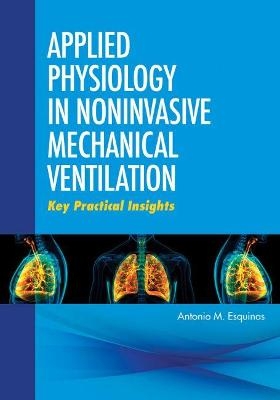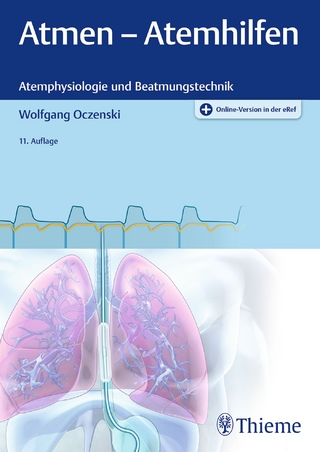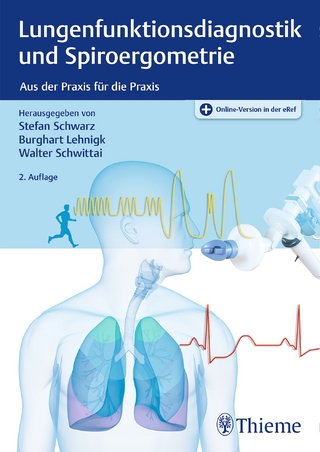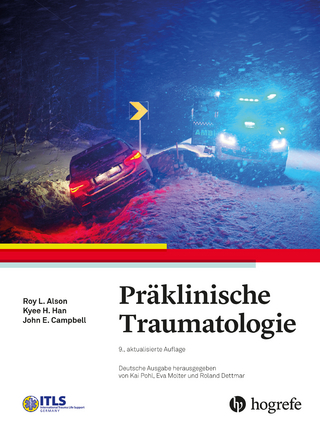
Applied Physiology in Noninvasive Mechanical Ventilation
PMPH-USA Limited (Verlag)
978-1-60795-300-5 (ISBN)
- Keine Verlagsinformationen verfügbar
- Artikel merken
Focused on understanding how lung physiology interacts with noninvasive ventilation, this book will be an excellent reference for pulmonologists, anesthesiologists, critical care physicians, and emergency medicine physicians in their treatment and care of patients with acute and chronic respiratory disorders.
The book's 67 chapters are divided into six sections that take the reader through (1) pulmonary physiology as it interacts with noninvasive mechanical ventilation (NIV), physiology of the respiratory muscles, structure and function of lung mechanics; (2) the interaction of lung physiology with positive pressure, extrapulmonary response (hemodynamic-ventilation interactions); (3) gas exchange and applied physiology during NIV; (4) interactions of lung mechanics with NIV in terms of pressure, volume, flow, monitoring, testing of pulmonary function; (5) NIV technology: interface and mechanical ventilators, patientventilator synchrony, ventilatory modes, monitoring patientventilator interaction; (6) physiopathologic perspective on clinical applications of NIV.
Antonio M. Esquinas, MD, PhD, is Director of the International School of Noninvasive Ventilation, and staff physician of the Intensive Care Unit at the Hospital Morales Meseguer in Murcia, Spain.
Preface
Contributors
PART 1. PULMONARY PHYSIOLOGY APPLIED FOR NONINVASIVE VENTILATION
Section 1. Breathing Pattern and Lung Interactions
Chapter 1. Spontaneous respiratory breathing: physiology by Henry B. Alanez Saavedra and Gabriel J. Moreno Gonzalez
Chapter 2. Breathing patterns and neurologic response: loop neurological - lung mechanics interactions by Maria Alvarenga Santos and Antonio M. Esquinas
Chapter 3. Breathing pattern classifications: apnea, hypopnea, and tachipnea by Gonzalo Segrelles Calvo, Estefania Llopis, Daniel Lopez-Padilla, and Enrique Zamora
Chapter 4. Pulmonary-biochemical and physical reflex interactions by Nidia Nanci and Pestana Caires
Section 2. Physiology of Respiratory Muscles
Chapter 5. Respiratory muscle weakness and fatigue: concept and clinical implications by Gaetano Scaramuzzo, Corrado Mollica, and Savino Spadaro
Chapter 6. Respiratory accessory muscular inspiratory function: clinical evaluations and implications by Laura Anguela Calvet and Juan C. Lopez-Delgado
Chapter 7. Respiratory expiratory muscular function: clinical evaluations and implications by Irene Nieto Codesid and Pedro J. Marcos
Chapter 8. Respiratory muscle per formance: key determinants in evaluation and monitoring by Elvira-Markela Antonogiannaki, Michail Fanaridis, and Eumorphia Kondili
Chapter 9. Summary and key practical tools to assess muscular response pattern response by Olga Moreno Romero, Alber to Fernandez Carmona, and Ana Maria Perez Bailon
Section 3. Lung Mechanics, Compliance, and Resistance
Chapter 10. Thorax: structure and function by Luca Salvatore De Santo, Angelo Ausania, Carlo Zebele
Chapter 11 . Compliance and applied physiology for noninvasive ventilation: function and anatomical determinants by Carmen Hernandez
Chapter 12. Airway resistance: function and anatomical determinants by Stavros Tryfon
Chapter 13. Restrictive respiratory failure: applied physiology and clinical implications by Dimitrios Lagonidis
PART 2. POSITIVE PRESSURE AND INTERACTION WITH LUNG PHYSIOLOGY
Section 1. Positive Pressure, Physics, and Implications
Chapter 14. Interactions: positive pressure ventilation and lung physiology by Jakob Wittenstein
Chapter 15. Negative noninvasive ventilation by Umberto Vincenzi
Chapter 16. Physiological interactions of high-flow nasal cannula therapy by Pedro Silva Santos
Section 2. Extrapulmonary Response: Hemodynamic-Ventilation Interactions
Chapter 17. Preload and lef t ventricular workload: cardiac output interactions by Lorena Olivencia Pena, Juan Jose Cruz Rueda, and Alber to Fernandez Carmona
Chapter 18. Noninvasive ventilation and hemodynamic interactions by Eylem Tuncay and Goekay Gungoer
Chapter 19. Summary and key practical tools to assess hemodynamic response to noninvasive ventilation by Jacobo Bacariza
PART 3. GAS EXCHANGE AND APPLIED PHYSIOLOGY DURING NONINVASIVE VENTILATION
Chapter 20. Gas exchange physiology by Paolo Banfi
Chapter 21. Hypoxemic conditions: Fi02/oxygenation, pat terns of response, and classifications by Chinmaya Panda and Subrata Singha
Chapter 22. Hypercapnic conditions: pat terns of response, classifications, and rebreathing by Juan Jose Cruz Rueda, Lorena Olivencia Pena, and Alber to Iglesias Santiago
Chapter 23. Practical tools to assess the impact of noninvasive ventilation on gas exchange by Habib Mohammad Reazaul Karim and Pradipta Bhakta
PART 4. INTERACTIONS OF LUNG MECHANICS WITH NONINVASIVE VENTILATION
Section 1. Pressure, Volume, and Flow
Chapter 24. Lung mechanics and airways: implications for clinical practical decisions by Burhan Sami Kalin and Gul Gursel
Chapter 25. Lung mechanics and compliance by Preet Mohinder Singh and Amit K. Malviya
Section 2. NIV Monitoring
Chapter 26. Monitoring lung function: pressure, volume, and f low; basic curves; interpretation and key determinants by Teresa Diaz de Teran, Antonello Nicolini, and Paolo Banfi
Chapter 27. Expirator y volume: concept and clinical implications by Oya Baydar Toprak and Ezgi OEzyilmaz Sarac
Chapter 28. Pulse oximetry and noninvasive ventilation applications by Antonio Pisano, Diana Di Fraja, and Manuela Angelone
Chapter 29. Transcutaneous capnography tracings and noninvasive ventilation by Muge Aydogdu
Chapter 30. Diaphragm electrical activity and implications during noninvasive ventilation by Savino Spadaro, Mar ta Lazzeri, and Alber to Fogagnolo
Chapter 31 . Electrical impedance tomography and radiologic CT scan evaluation during noninvasive ventilation by Thierry Hernandez-Gilsoul
Section 3. Pulmonary Function Test
Chapter 32. Lung volumes and vital capacity: measurement , determinants, and implications by Alberto Fernandez Carmona
Chapter 33. Cough and flow measurement : measurement , determinants, and implications during noninvasive ventilation by Alber to Fernandez Carmona
PART 5. NONINVASIVE VENTILATION TECHNOLOGY
Section 1. Inter face and Mechanical Ventilators
Chapter 34. Implications of ventilator inter face and lung physiology by Antonio M. Esquinas, Giuseppe Fiorentino, and Anna Annunziata
Chapter 35. Classification of noninvasive ventilators: technical and practical issues by Raffaele Scala
Chapter 36. Noninvasive ventilator sof tware: estimating ventilation, tidal volume, and leaks by Manel Lujan Torne
Chapter 37. Critical care mechanical ventilators: accuracy-positive pressure, flow measurements, tidal volume, leak measurements by Antonio Esquinas, Habib Mohammad Reazaul Karim, and Subrata Singha
Chapter 38. Effects of leak compensation on patient-ventilator synchrony by Hadil A . Al Otair and Ahmed S. BaHammam
Section 2. Patient-Ventilator Synchrony and Ventilatory Modes
Chapter 39. Ventilator-patient synchronization during noninvasive ventilation by Zbigniew Szkulmowski
Chapter 40. Pressure support ventilation by Alberto Bordo and Enrico Perretta
Chapter 41 . Inspiratory positive airway pressure: concept , clinical implications, and technology by Bushra Mina and Oki Ishikawa
Chapter 42. Expiratory positive airway pressure: concept , clinical implications, and technology by Karthik Seetharam, Antonio M. Esquinas, and Bushra Mina
Chapter 43. Noninvasive ventilation ramp option on pressure support : lung-patient interactions by Gonzalo Segrelles Calvo, Nestor Luis Rodriguez Melean, and Estefania Llopis
Chapter 44. Neurally adjusted noninvasive ventilation by Ilaria Sguazzotti, Gianmaria Cammarota, and Carlo Olivieri
Chapter 45. Use of noninvasive ventilation with adaptive servo ventilation: practical implications by Killen H. Briones-Claudett
Chapter 46. CPAP devices: algorithms and equipment by Vania Fernandes and Margarida Alonso
Chapter 47. CPAP and auto-CPAP mode in obstructive sleep apnea by Paola Pierucci
Chapter 48. Key determinants of noninvasive ventilation withdrawal by Bushra Mina
Section 3. Monitoring Patient-Ventilator Interaction
Chapter 49. Monitoring patient-ventilator interactions by Emine Aksoy and Zuhal Karakurt
Chapter 50. Patient ventilator asynchrony: frequency and types by Lars-Olav Harnisch and Onnen Moerer
Chapter 51 . Patient ventilator asynchrony: clinical conditions and pathophysiological disease by Kamil Inci and Gul Gursel
Chapter 52. Auto-positive expiratory pressure: concepts and implications in noninvasive ventilation by Serena Wei J. Hsia and Catherine S. Sassoon
Chapter 53. Impact of inspiratory positive airway pressure on patient ventilator asynchrony; key practical recommendations by M.L. Duiverman and S. Van der Leest
Chapter 54. Impact of expiratory positive airway pressure on patient ventilator asynchrony; key practical recommendations by Milind P. Sovani
Chapter 55. Asynchrony and noninvasive ventilation: summary of clinical and bench studies by Dhruva Chaudhry
Chapter 56. Experience of the medical team and patient-ventilator asynchrony, by Lindsay Lief and Lourdes Sanso
Chapter 57. Tools and key practical insights for noninvasive ventilation response and evaluation: concept and implications of early and late failure by Guy W. Soo Hoo
PART 6. Basic Clinical Applications for Noninvasive Ventilation, Physiopathology Perspective
Chapter 58. Acute and chronic hypercapnic respiratory failure: determinants and evaluation by Krystel Maisterra Santos and Juan C. Lopez-Delgado
Chapter 59. Acute hypoxemic respiratory failure by Isaac Chouris and Dimitrios Lagonidis
Chapter 60. Physiology of noninvasive ventilation in acute cardiac failure by Zehra Hatipoglu
Chapter 61 . Physiology of noninvasive ventilation in heart failure in postoperative respiratory failure by Athanasia Proklou, Eleni Diamantaki, Emmanouil Pediaditis, and Eumorfia Kondili
Chapter 62. Physiology of noninvasive ventilation in hear t failure in obesity hypoventilation by Preet Mohinder Singh and Basavaraj Ankalagi
Chapter 63. Diagnosis and technical aspects of noninvasive positive pressure ventilation in hypoventilation syndromes by Ugur OEzdemir and Gul Gurse
Chapter 64. Physiology and noninvasive ventilation in sleep-related hypoventilation syndromes by Claudio De Michelis
Chapter 65. Noninvasive ventilation in long-term applications by Francesco Balbi, Alberto Bordo, and Claudio De Michelis
Chapter 66. Lung physiology during ventilatory complementary technologies: aerosoltherapy, humidification, and cough assisted by Soraya Jodra Sanchez and Jair Jose Rauseo Lopez
Chapter 67. Noninvasive ventilation in pulmonary rehabilitation and lung physiology in exercise by Virginia Guevara Velasco and Milagros Teresa Rosales Dedios
| Erscheinungsdatum | 31.12.2019 |
|---|---|
| Verlagsort | Shelton |
| Sprache | englisch |
| Maße | 216 x 279 mm |
| Themenwelt | Medizinische Fachgebiete ► Innere Medizin ► Pneumologie |
| Medizin / Pharmazie ► Medizinische Fachgebiete ► Notfallmedizin | |
| Studium ► 1. Studienabschnitt (Vorklinik) ► Physiologie | |
| ISBN-10 | 1-60795-300-5 / 1607953005 |
| ISBN-13 | 978-1-60795-300-5 / 9781607953005 |
| Zustand | Neuware |
| Haben Sie eine Frage zum Produkt? |
aus dem Bereich


